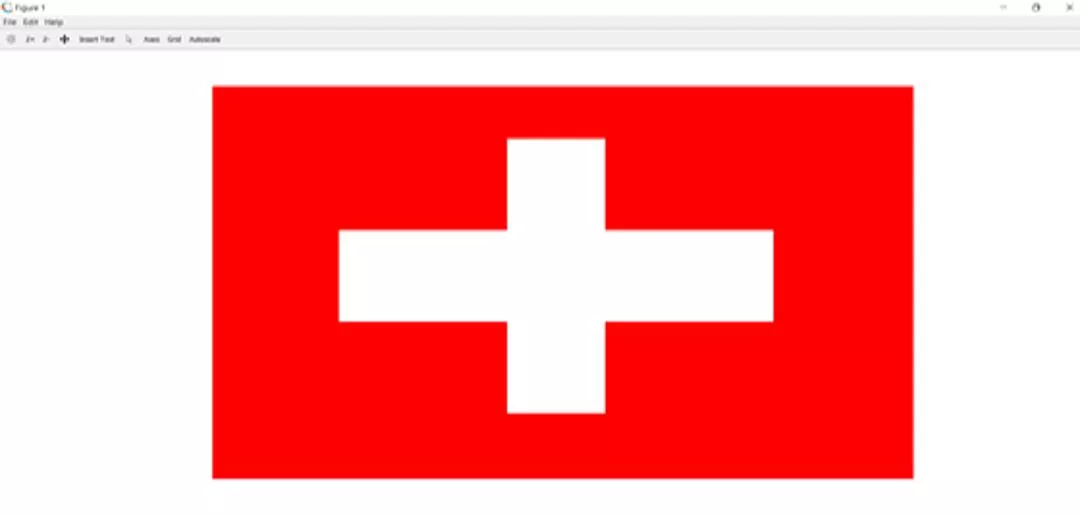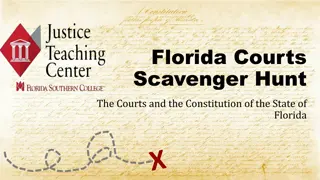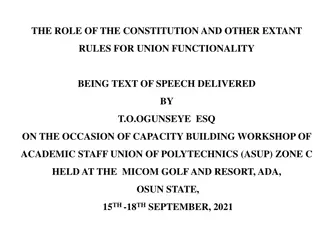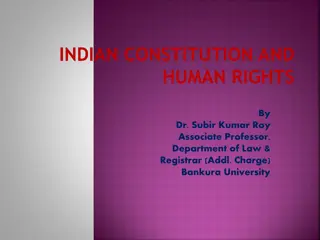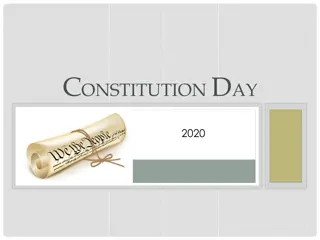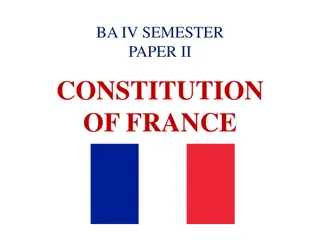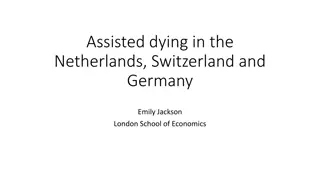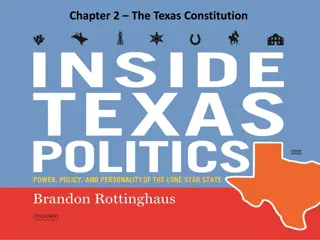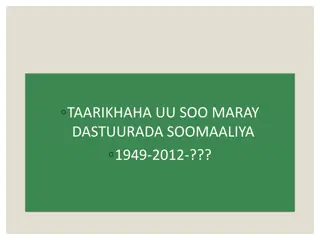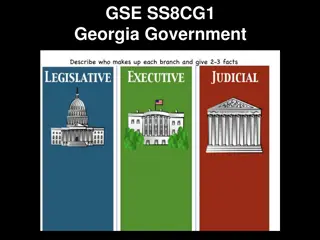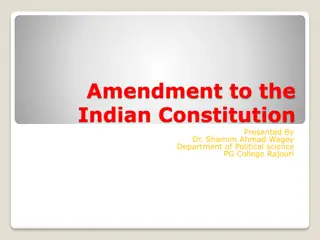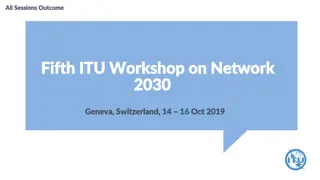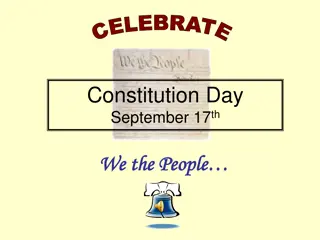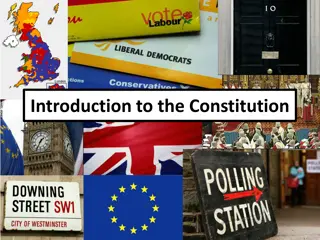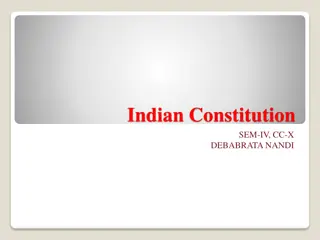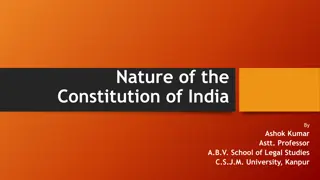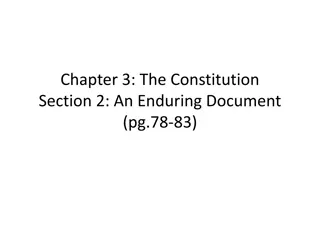Evolution of the Constitution in Switzerland
The Republic of Switzerland, a federal republic with 26 cantons, has evolved through three major constitutions - 1848, 1874, and 1999. Over the years, Switzerland has seen significant changes in its political structure, moving from a confederation to a federation and embracing unique features like Direct Democracy and a Plural Executive. The latest constitution of 1999 reflects a blend of parliamentary and presidential elements, along with tools of Direct Democracy, dual citizenship, and a strong emphasis on the rule of law.
Download Presentation

Please find below an Image/Link to download the presentation.
The content on the website is provided AS IS for your information and personal use only. It may not be sold, licensed, or shared on other websites without obtaining consent from the author.If you encounter any issues during the download, it is possible that the publisher has removed the file from their server.
You are allowed to download the files provided on this website for personal or commercial use, subject to the condition that they are used lawfully. All files are the property of their respective owners.
The content on the website is provided AS IS for your information and personal use only. It may not be sold, licensed, or shared on other websites without obtaining consent from the author.
E N D
Presentation Transcript
Constitution of Switzerland
Introduction The Republic of Switzerland is a small country in Europe. It is a federal republic consisting of 26 cantons or states. The capital of Switzerland is Bern whereas Geneva and Zurich are other world famous cities of this country. Switzerland is home to some unique political features such as tools of Direct Democracy and Plural Executive . Switzerland is a neutralised country, the status has been conferred on Switzerland by an International Treaty.
Historical and Constitutional Development Switzerland is the product of a process of unification which commenced in the year 1291 and was completed by 1848. From the year 1848 till 1999 , Swiss people have witnessed three constitutions. The Constitution of 1848 The Constitution of 1874 The Constitution of 1999
Features of the Constitution of 1848 Switzerland was converted from Confederation to the Federation. The Constitution Bicameral Federal Assembly, the Collegial or Plural Executive, Referendum, Common citizenship and Federal Tribunal. made provision for Initiative,
Features of the Constitution of 1874 Swiss Constitution and after the approval through referendum, it came into operation on May 29, 1874. It had contained 123Articles. Power of the Centre had enhanced significantly. Powers of federal Tribunal were enhanced. The separate Judicial system of Cantons were abolished. Federal Assembly framed the new
The Constitution of 1999 The draft constitution was adopted by the Swiss federal Assembly on December 18, 1998, and adopted by a Referendum on April 18, 1999. The parliament issued the Enforcement decree on September 28,1999, and the new Constitution came into force on January 1, 2000.
Salient features of the Constitution Awritten and enacted constitution, consists of 196Articles. Rigid Constitution because procedure of amendment is complicated. Plural Executive- All executive powers of the federation are exercised by a seven member federal government. Bicameral Legislature- Upper House of the Swiss Parliament is Council of States and the Lower House is the National Council Tools of Direct Democracy- Referendums, Initiatives and Landsgemeinde. Mixture of Parliamentary and Presidential forms. No Judicial Review over Federal Laws. Dual Citizenship. Rule of Law
Federal Executive or Federal Council Federal Executive or Federal Council is a plural executive of seven members, is elected by the Federal Assembly in a joint session of both the houses for the period of four years. All the nationalities of German, French and Italian are accorded representation in the Council in the ratio of four, two and one respectively. The seven members are elected as equals and without any attribution to a particular department.
After their election, the members of the Federal Council decides on the distribution of the departments. They give their preference in order of seniority and in case of contest, the majority principles applies. One of the members of the Council is annually elected as the President while another is chosen as Vice-President. By convention, this process continues and each member gets chance to become President and Vice-President.
The President enjoys no political privileges and mainly perform formal duties. The Federal Council, as a collective body, is the Swiss head of the state The members of the federal Council do not resign whenever the federal parliament rejects any measures or policy sponsored by it, therefore there is no such thing as collective responsibility before the federal parliament.
Functions of the Federal Executive The Federal Council is the supreme executive and governing authority with far reaching constitutional powers. The Federal Council decides collectively on all important issues The Federal Council defines the general aims and instruments of federal policy and plans and coordinates the corresponding activities. It determines foreign affairs and defence policy and directs the administration and the implementation of all the federal policies. In relation to legislation, it organizes the pre-parliamentry process and no bill comes before legislation unless it is first considered by the concerned member of the Council.
Federal Assembly Parliament in Switzerland is called Federal Assembly consisting of two houses the representing the people and the Council of States representing the Cantons. Both the houses can initiate constitutional amendments, bills and propose the revision of laws Every bill must be approved by a majority of both the houses and if bill fails to win majority in any of the houses , then both adopt procedures to sort out the differences which eventually led to the passing of the bill. National Council
National Council National Council represents the people of Switzerland and its 200 members are directly elected for four years. The seats in National Council is divided among 26 Cantons according to their share in population.
Council of the States The Council of the States is composed of two members from every full canton(20) and one member from each half-canton(6), resulting in a total of 46 members. Members of the Council of the State are elected directly by the people of the Cantons and their tenure depend upon the Cantons which they represent.
Procedure of Amendment of the Constitution Amendment procedure of the Swiss constitution is complicated that's why it is termed as a rigid constitution. Swiss federal Assembly can propose for the amendment in the constitution or One lakh Swiss voters through an initiative can ask the federal Assembly to begin with a constitutional amendment. In both cases, the proposal become a part of the constitution only when referendum by a majority of Swiss voters as well as by a majority of the Cantons. approved in a it is
Tools of Direct Democracy Three landsgemeinde. Referendum-Under the system of referendum, the people have the right to approve or disapprove the laws amendments passed by their legislature. The decision of referendum is final. tools- Referendum, Initiative and or constitutional
Initiative- Under the system of Initiative one lakh Swiss voters can initiate any proposal for constitutional amendment. Landsgemeinde- In one full Canton and five half cantons of Switzerland institution of Landsgemeinde. It is a Cantonal Council of all the voters which makes laws, approves policies and elects the executive for running the administration. there is a
Swiss Judicial System The Swiss federal Court is the only federal court and considered as Switzerland. The judges of the court are elected by the federal assembly for a period of six years, re-election can be done. The judges are responsible before the federal Assembly. No Judicial Review over the federal laws rather Federal Court has been given the power to review laws made by the Cantonal legislatures. the supreme court of


